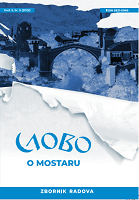BIŠĆE I BLAGAJ U ODLUKAMA VIJEĆA DUBROVAČKE REPUBLIKE U 15. STOLJEĆU – ISPISI ARHIVSKE GRAĐE
BIŠĆE AND BLAGAJ IN THE DELIBERATIONS OF THE RAGUSAN COUNCILS IN THE 15TH CENTURY - EXCERPTS FROM ARCHIVAL SOURCES
Author(s): Enes DedićSubject(s): Cultural history, Diplomatic history, Local History / Microhistory, Political history, Social history, 15th Century
Published by: Fakultet humanističkih nauka, Univerzitet »Džemal Bijedić« u Mostaru
Keywords: Bišće; Blagaj; Republic of Dubrovnik; The Kosačas; councils; 15th century;
Summary/Abstract: Bišće and Blagaj were located on an extremely important road network that connected Ragusa with internal economic and political centers. Favorable geostrategic position conditioned that this area was inhabited in the early Middle Ages and that fortiications were built in it. Bišće and Blagaj are frequently mentioned in archival documents of the 15th century, but their correlation with the oldest data on settlements in this area is still not clearly deined. Since the irst half of the 14th century, they have been an integral part of the Bosnian state. he court of Bosnian rulers was located in the area of Bišće, and from the beginning of the 15th century the administration of this area was exercised by the Bosnian noble family Kosača and kept until the Ottoman conquest in 1468 at the latest. Blagaj is irst mentioned in archival documents in 1423, but it is quite certain that the city was built much earlier. Appearances of these places in historical sources are related to issues of political and diplomatic nature. An analysis of the series of Dubrovnik State Archives, Reformationes, Acta Consili Rogatorum, Acta Minori Consili, and Acta Consili Maioris, indicates that during that period Bišće and Blagaj were subjects of 85 decisions or groups of several consecutive decisions of the Ragusan Council. Statistically, 58 decisions apply to Blagaj and 28 to Bišće. he most information about Bišće and Blagaj is provided by the series Acta Consili Rogatorum with 54, Acta Consili Maioris with 20, Acta Minori Consili with 9, and Reformationes with 2 mentions. In the irst four decades of the 15th century Bišće is mentioned much more often, while Blagaj is mentioned from 1428 to 1492. hese are short excerpts in which the decisions of a certain council on the inquiry or the problem that arose were deined. Most of the decisions relate to the debate over the gifting of Bosnian rulers, nobles of the Kosača family, or later Ottoman oicials, who were staying in Blagaj or Bišće at the time. he most common gift was ish. he value of the gift ranged between 30 and 50 perpers. Discussions about customs in Bišće can be seen through this type of source. he data from these documents provide clear information about the time of stay of Bosnian rulers and nobles in these places, their stay in Bišće and Blagaj is most intense in the periods February-March, and November-December.
Journal: Slovo o
- Issue Year: 5/2022
- Issue No: 5
- Page Range: 21-61
- Page Count: 41
- Language: Bosnian

